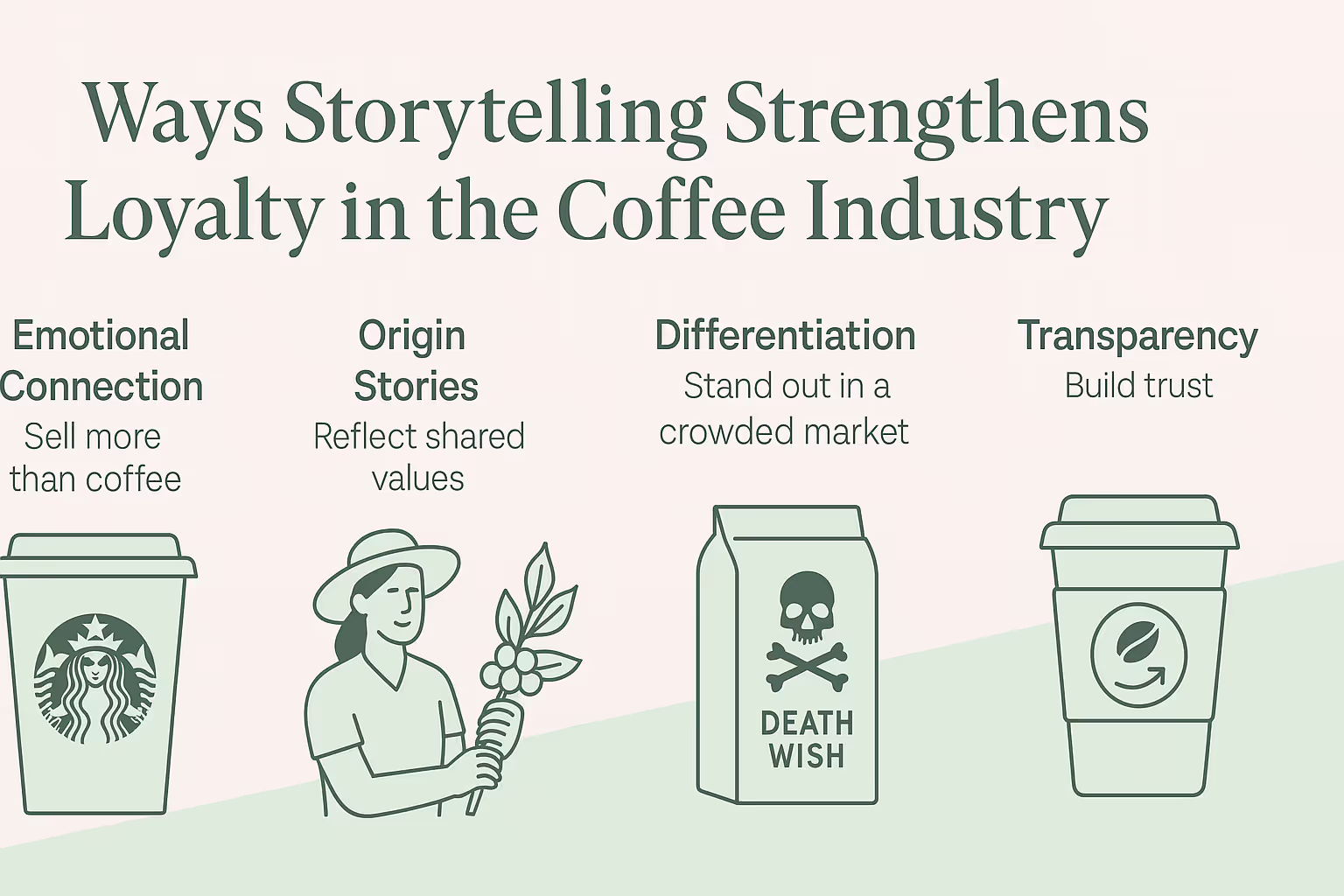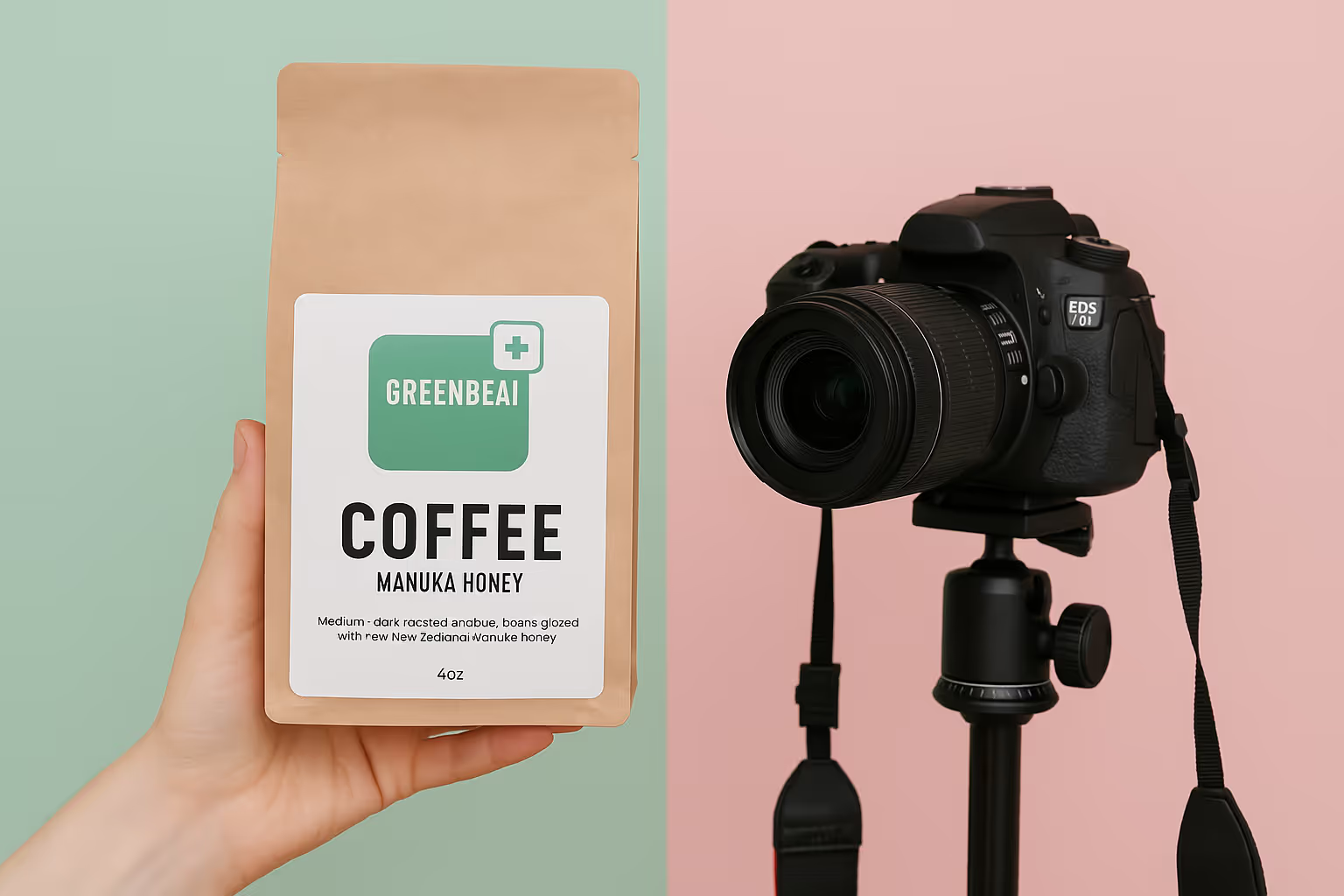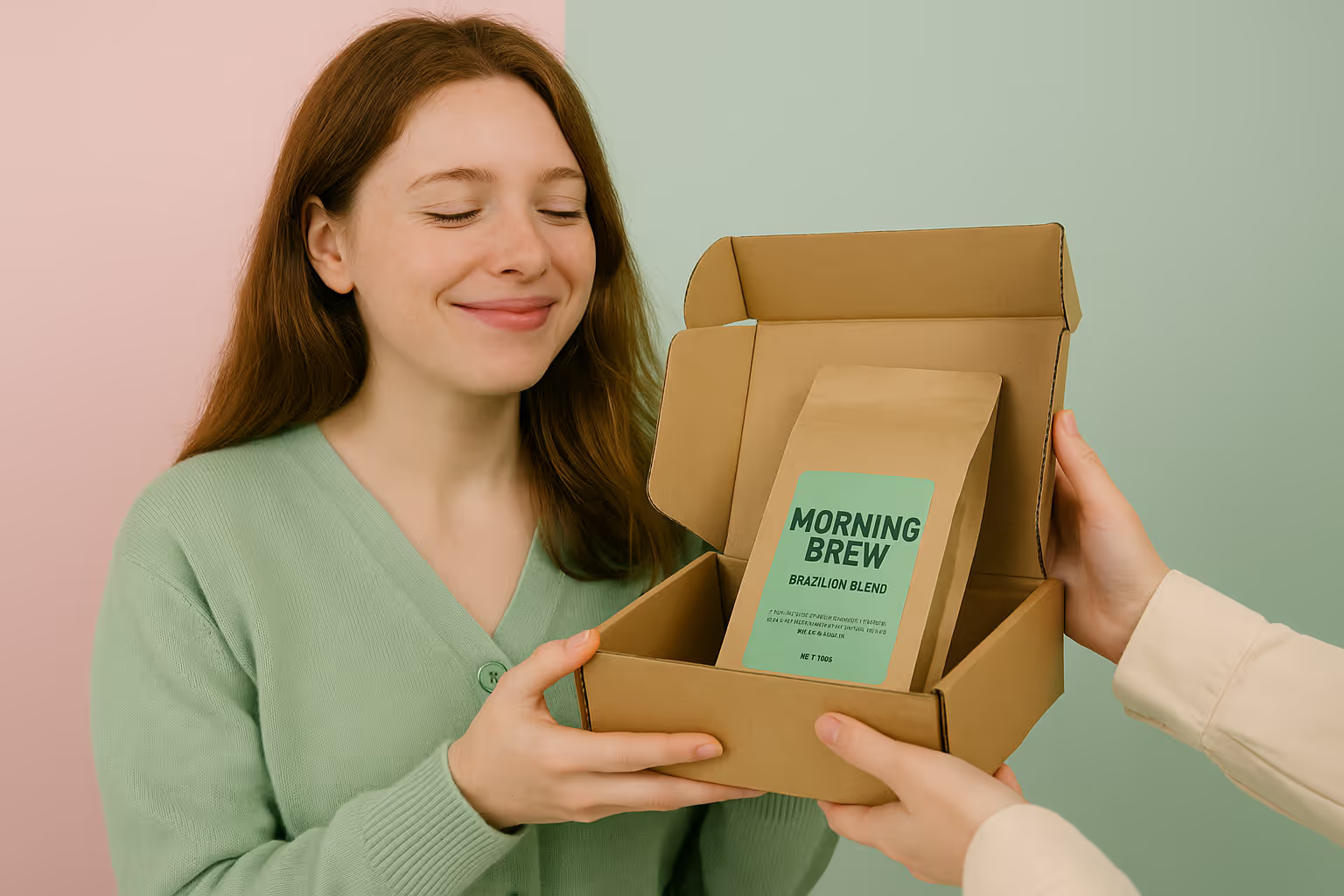How Does Storytelling Impact Loyalty in the Coffee Industry? Different Impacts

The global coffee market is projected to reach over $144 billion by 2025, driven by specialty brews and ethical sourcing. With 73% of consumers more likely to stay loyal to brands that tell meaningful stories, coffee companies must go beyond quality beans.
As competition heats up, storytelling becomes a powerful differentiator. It’s not just packaging; it’s about emotional connection.
That’s why it’s worth asking: how does storytelling impact loyalty in the coffee industry? A compelling narrative transforms a simple cup into a ritual, reflecting values, origins, and identity. This emotional depth fosters brand affinity and lasting trust.
Ways Storytelling Strengthens Loyalty in the Coffee Industry
Coffee isn't just a drink. It’s a habit, a ritual, and for many, part of their identity. That’s why the most loyal coffee buyers connect with more than just taste—they connect with the story behind the cup.

1. Emotional Connection: Sell More Than Coffee
Great coffee brands don’t lead with product specs; they lead with purpose.
Starbucks pioneered the idea of the “third place,” not home, not work, but a cozy space where people feel welcome.
That emotional positioning turns a $6 latte into a lifestyle.
Pro Tip: Build your brand around a human truth, belonging, identity, aspiration, not just beans and brewing.
2. Origin Stories That Reflect Shared Values
Smaller, specialty brands thrive on storytelling about farmers, regions, and sustainable practices.
Example:
A brand that highlights its direct-trade relationship with Rwandan growers gives buyers a sense of ethical pride in every purchase.
Pro Tip: Show how your brand’s sourcing or production supports a greater mission (climate, fair pay, local economies).
3. Differentiation in a Crowded Market
When price and quality are comparable, narrative is the only real differentiator.
Example: Death Wish Coffee stands out by claiming to be “the world’s strongest coffee,” turning a niche promise into a bold identity.
Pro Tip: Position your story around a unique claim—strength, sustainability, speed, serenity, and own it unapologetically.
4. Transparency Builds Trust
Today’s coffee lovers care about how their brew got to them.
- Where was it sourced?
- How were the farmers treated?
- Is the process sustainable?
Telling this story with specifics, not vague claims, creates trust and makes buyers feel they’re part of something good.
Pro Tip: Use visuals or short videos to trace your product’s journey “from bean to cup.”
5. Story = Retention
When customers connect with your why, they return, not just for the taste, but for how it makes them feel.
A great story turns one-time buyers into long-term advocates who share your mission with others.
Effective Storytelling Elements in Successful Coffee

The most loyalty-generating coffee brands incorporate several key storytelling elements that resonate deeply with consumers:
Origin Stories That Connect and Inspire
Origin stories create foundational narratives that customers can connect with emotionally. Consider Blue Bottle Coffee, whose name and brand identity stem from Europe's first coffee house in Vienna in the 1600s.
This historical connection gives customers a sense of participating in a centuries-old tradition.
Successful coffee promotion through content marketing often centers around these origin narratives, whether they focus on:
- The founder's journey
- The discovery of unique beans or brewing methods
- Cultural traditions behind specific coffee varieties
- The mission and purpose that drove the brand's creation
Character-Driven Narratives
People connect with people, not abstract concepts. Smart coffee brands put characters at the center of their stories:
The Farmers Behind the Beans
Brands like Counter Culture Coffee share detailed profiles of the farmers who grow their beans, complete with photos, personal stories, and information about their communities. These narratives transform anonymous agricultural products into personal connections.
The Founder's Journey
Philz Coffee leverages founder Phil Jaber's story of spending seven years perfecting his blends before opening his first shop.
This narrative of perfectionism and passion resonates with customers who see their purchase as supporting an individual's dream rather than just a corporation.
The Customer as Hero
The most powerful stories often position the customer as the protagonist. Brands like Death Wish Coffee create narratives where their customers are portrayed as bold, hardworking individuals who deserve an exceptional coffee experience. This makes loyalty feel like self-affirmation.
Sensory Storytelling That Evokes Experience
Coffee is inherently sensory, and effective storytelling leverages this quality:
- Descriptions of flavor notes that transport customers to exotic locations
- Visual storytelling through packaging that hints at the experience within
- Narrative-driven tasting notes that guide the customer's sensory journey
- Cafe environments are designed to physically immerse customers in the brand story

Implementing Storytelling Across Customer Touchpoints
For coffee brands looking to build loyalty through storytelling, consistency across all touchpoints is essential:
Digital Storytelling Strategies
In the digital realm, coffee brands can leverage multiple channels for storytelling:
Website Narrative Architecture
Your e-commerce website should be more than a product catalog; it should be a storytelling platform. Consider how a specialty coffee brand can create its own unique identity through well-crafted website stories. Effective websites include:
- Immersive "About Us" pages that go beyond company facts to share emotional narratives
- Product descriptions that tell the story behind each blend or single-origin offering
- Blog content that deepens the narrative with behind-the-scenes insights
- Visual elements that reinforce the brand story
Social Media as a Storytelling Canvas
Social media provides ideal platforms for episodic storytelling that builds community. Coffee brands can use these channels to:
- Share day-in-the-life content from farms and roasteries
- Create serialized content that keeps followers engaged over time
- Promote coffee through visually compelling social media narratives that showcase the product journey
- Encourage user-generated content that makes customers part of the brand story
Email Marketing Narratives
Email provides a direct line to your most engaged customers. Effective email marketing strategies for coffee brands often include:
- Sequential welcome series that gradually unfolds the brand story
- Behind-the-scenes content that makes subscribers feel like insiders
- Storytelling around seasonal offerings and limited editions
- Narratives that educate customers about brewing methods and coffee appreciation
Physical Storytelling Environments
For coffee brands with physical locations, the environment itself becomes a storytelling medium:
Packaging as a Narrative Device
Product packaging is often the first tangible interaction customers have with a coffee brand. Effective packaging:
- Visually communicates brand values and story
- Includes narrative elements like origin information, farmer profiles, or brand history
- Creates an unboxing experience that extends the story
- Serves as a daily reminder of the brand narrative in customers' homes
Cafe Design That Embodies the Story
For brands with physical locations, every design element should reinforce the core narrative:
- Interior design that reflects brand origins or values
- Staff training that equips team members to share brand stories
- Menu design that communicates the narrative behind each offering
- Sensory elements (music, scent, lighting) that create immersive storytelling environments
Measuring the Impact of Storytelling on Coffee Brand Loyalty
Storytelling's impact on loyalty can be measured through several key metrics:
Direct Loyalty Indicators
- Repeat purchase rates compared to industry averages
- Subscription program adoption and retention
- Customer lifetime value increases over time
- Referral rates from existing customers
Indirect Loyalty Indicators
- Social media engagement with story-driven content
- User-generated content volume and sentiment
- Community participation (events, classes, online forums)
- Premium price tolerance for products with compelling narratives
Pro tip: Track which specific stories or narrative elements generate the most engagement and loyalty behaviors, then develop a storytelling framework that emphasizes these high-performing narrative types.
For example, if farmer profiles consistently outperform other content types, consider expanding this storytelling thread across more touchpoints.
Innovative Storytelling Approaches in Modern Coffee Brands
Forward-thinking coffee brands are pushing storytelling boundaries with innovative approaches:
Transparency as Radical Storytelling
Some brands are taking transparency to new levels, sharing previously hidden aspects of the coffee business:
- Revealing actual costs and profit margins throughout the supply chain
- Documenting challenges and failures alongside successes
- Sharing environmental impact data in transparent, accessible ways
- Involving customers in product development storytelling
Interactive and Co-Created Narratives
Modern coffee brands are inviting customers to participate in the storytelling process:
- Creating limited edition products based on customer stories
- Developing community-sourced content for marketing campaigns
- Using QR codes on packaging that unlock expanded digital stories
- Hosting storytelling events where customers share their coffee experiences
Emerging Storytelling Technologies
New technologies are creating fresh storytelling possibilities:
- Augmented reality experiences that bring coffee origins to life
- Blockchain-verified storytelling that authenticates ethical claims
- Interactive packaging that delivers dynamic content
- Virtual experiences of farms and production facilities

Avoiding Common Coffee Storytelling Pitfalls
While storytelling is powerful, coffee brands must navigate several common pitfalls:
Authenticity Failures
When stories feel manufactured or disingenuous, they can damage loyalty:
- Claiming ethical practices without verification
- Appropriating cultural narratives without proper context or respect
- Overstating environmental benefits ("greenwashing")
- Creating fictional narratives that mislead about product origins
Narrative Inconsistency
Conflicting or constantly changing narratives create confusion rather than loyalty:
- Shifting brand values to chase trends
- Disconnects between marketing stories and actual customer experiences
- Inconsistent storytelling across different channels or touchpoints
- Failure to evolve stories organically as the brand grows
Storytelling Without Substance
The most damaging pitfall is telling compelling stories about a subpar product:
- Beautiful narratives can't compensate for poor coffee quality
- Stories about exceptional service must be backed by actual exceptional service
- Claims about ethical sourcing require verifiable supply chain practices
- Environmental narratives demand genuine sustainability efforts
Crafting Your Coffee Brand's Loyalty-Building Story
The most effective coffee brand stories develop organically from authentic foundations:
Discovering Your Core Narrative
To find your brand's most powerful story:
- Identify what truly makes your coffee offering unique
- Uncover the authentic human elements behind your brand
- Determine which values resonate most with your target audience
- Find the intersection of your passion, your product quality, and customer needs
Developing a Multi-Channel Storytelling Strategy
Once you've identified your core narrative:
- Map customer touchpoints and create story elements for each
- Develop a content calendar that gradually unfolds your brand story
- Train team members to embody and communicate the narrative
- Create opportunities for customers to participate in the storytelling
Evolving Your Story While Maintaining Brand Identity
Effective stories grow with the brand:
- Regularly refresh storytelling elements while keeping core narratives consistent
- Incorporate customer stories into the evolving brand narrative
- Document new chapters in the brand journey authentically
- Use data and feedback to refine which story elements resonate most
Expert’s Advice: Use Micro-Stories to Strengthen Customer Loyalty
Beyond your brand’s big narrative, true loyalty often forms through micro-stories, brief, emotional moments woven into everyday interactions.
Think handwritten notes on packaging, the origin behind a limited roast, or a quick “Roaster’s Reflection” in emails.
These subtle details humanize your brand and give customers something personal to connect with and share.
When aligned with your larger story, micro-stories create a richer, more intimate brand experience that keeps customers coming back, not just for the coffee, but for the connection.
Brewing Success: The Future of Coffee Storytelling
The coffee industry keeps evolving, but one thing stays the same: authentic storytelling builds deeper connections. As technology and consumer expectations grow, brands have more ways than ever to use storytelling to inspire loyalty.
The strongest coffee brands will blend tradition with innovation, turning daily coffee habits into meaningful rituals.
Whether you're scaling or just starting, storytelling should anchor your strategy. Share the unique stories only your brand can tell across every touchpoint.
The best coffee stories aren’t just told; they’re felt, shared, and lived. When customers see themselves in your narrative, that’s when true loyalty begins to brew.
FAQ
Related blogs

Influencer Pricing Calculator: Find Your Fair Rate for Posts, Reels & Stories
.avif)
How To Market Pet Products Through Storytelling: Win Attention, Build Trust, and Boost Sales Naturally
.avif)
How To Market Coffee To Gen Z: The High-Impact Blueprint Every Brand Needs
.avif)

